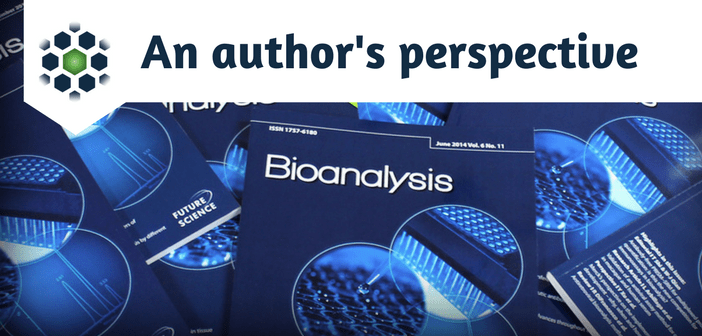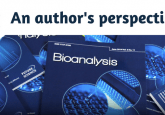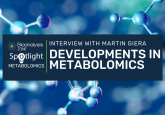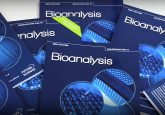An author’s perspective: Chris Zhu on MS-based metabolomics

To help provide insight into the recent article published in Bioanalysis, (Mass spectrometry based metabolomics: a novel analytical technique for detecting metabolic syndrome?), we spoke with author Jiangjiang (Chris) Zhu, Assistant Professor at Miami University of Ohio (OH, USA). Chris explains why he felt this was an important area for bioanalysis and worthy of publication. His work focuses on emerging technologies and MS-based metabolomics.
“My name is Jiangjiang (Chris) Zhu, I am currently an Assistant Professor in the Department of Chemistry and Biochemistry at Miami University of Ohio (OH, USA) and my research group focuses on accurate, sensitive and quantitative measurement of small molecules such as metabolites. My bioanalysis training started when I was a graduate student at the University of Vermont (VT, USA) working with Professor Jane E. Hill (who is now at Dartmouth College, NH, USA). We were really interested in small molecule detection in gas phase, for which we detected a variety of volatile organic compounds emitted from pathogenic bacteria to assist the diagnosis of infectious diseases. After completing my PhD, I continued working in the bioanalytical field with a specific focus in metabolomics, as I became a Senior Fellow at the University of Washington Northwest Metabolomics Research Center (WA, USA). The years I worked with our Center Director, Professor Daniel Raftery, really inspired my further pursuit of research in small molecule detection, thus I continued to work on various metabolomics studies in my current research group.”
1. Could you describe some of the challenges of the bioanalysis of small molecules?
Despite the latest advancements in technology development, we are still facing many challenges in the small molecule analysis field. First of all, the identities for many small molecules in biological systems, such as the thousands of metabolites that are circulating around the human body, are still not fully revealed. When we have tens or even hundreds of statistically significant mass spectrum peaks detected in some given biological systems, it is critical for us to be able to identify the key players so the additional biological insights can be provided. Secondly, the absolute quantification approaches are not always readily available for small molecule measurement, especially for the quantification of small molecules in a complex mixture. Many factors, such as the matrix effect and the availability of internal standards could hinder the quantification of a large set of small molecules simultaneously. Finally, the stability and reproducibility of the analytical assays need to be constantly validated to ensure robust results to be generated for important biomedical studies.
2. Could you list/describe the key factors that need to be considered when introducing a new, emerging technology?
For bioanalytical technology development, we first have to identify the real need from the potential users/collaborators who will actually benefit from our technical innovation, so the development can be purposeful and geared to target specific groups of analytes. Then we should evaluate the advantages and limitations of the new technology in comparison to existing technologies, which will help us to justify whether such new technology would really provide additional benefit to our field of studies. Finally, the logistics, cost and labors that need to be involved in the new technology introduction and implementation will need to be evaluated. This is so the other socioeconomic factors beyond the scientific development can also be considered to make the best choice between different technologies.
You can find more content on emerging technologies: DMPK and bioanalysis of small molecules on our Spotlight page.
3. What are the advantages/disadvantages of using MS-based metabolomics?
MS based metabolomics embraced many bioanalytical advantages in metabolites studies ranging from high sensitivities, low detection limits and compatibility with a variety of separation techniques, to the ability to deliver quantitative data. These merits work together to make MS-based metabolomics an attractive approach to many biomedical studies that involve the investigation of metabolites. Nevertheless, many technical and methodological issues must be addressed to further assist our application of MS-based metabolomics in many sophisticated biomedical applications. For example, the high diversity and variability encountered in metabolomic investigations are still troubling. How could we introduce the samples of interest into the MS instruments efficiently and have their metabolites ionized the same fashion as in their original systems? These are questions that are still to be fully explored. Other major obstacles include data standardization, data analysis and interpretation strategies, as MS-based metabolomics tends to generate a huge amount of data and important biological information could potentially get lost if we don’t process the data carefully.
4. What further advances do you envisage with MS-based metabolomics in the future?
We envision that MS-based metabolomics will rapidly develop, therefore, one day we could really move these emerging metabolomics tools from bench to bedside. There are already studies out there that have reported instant disease diagnostics and monitoring using MS-based metabolomics, mostly in a small number of patients or limited clinical trials. With the novel and emerging development in ambient ionization-mass spectrometry, miniature/portable mass spectrometry and other related techniques, it is reasonable for us to expect some cutting-edge advancement in the next 5–10 years. We hope that MS-based metabolomics will eventually fulfill many onsite bioanalysis needs, from both disease diagnostics, screening, monitoring to surgery decision support.
Reference: Sallese A and Zhu J. Mass spectrometry based metabolomics: a novel analytical technique for detecting metabolic syndrome? Bioanalysis 9(21): 1623-1626 (2017)





